╔
Matosinhos. Cidade (de) futuro
Entrevista com Luísa SALGUEIRO, Presidente da Câmara Municipal de Matosinhos
Muito obrigado por aceitar esta entrevista para a PORTUS Portrait, centrada na cidade portuária de Matosinhos.
Matosinhos é uma cidade com uma relação umbilical com o mar, que faz parte do seu passado, do seu presente e do seu futuro. Nesse sentido, serão abordados nesta entrevista temas como a valorização da tradição e história coletiva de Matosinhos, a importância crescente de setores como a economia azul ou o turismo e a relação da cidade com o Porto de Leixões. De igual forma, é abordada a visão de futuro do Município de Matosinhos em temas como a sustentabilidade, o planeamento urbanístico e a competitividade económica do território.
Thank you very much for accepting this interview for PORTUS Portrait, focused on the port city of Matosinhos.
Matosinhos is a city with an umbilical relationship with the sea, which is part of its past, present, and future. With that in mind, this interview will cover topics such as the appreciation of the tradition and collective history of Matosinhos, the growing importance of sectors such as the blue economy or tourism and the relationship of the city with the Leixões’s Port. In the same way, the vision for the Municipality of Matosinhos’s future in topics such as sustainability, urban planning and economic competitiveness of the territory is also going to be addressed.
ENTREVISTADOR | José Luis ESTRADA, Diretor de PORTUS
ENTREVISTADA | Luísa SALGUEIRO, Presidente da Câmara Municipal de Matosinhos
INTERVIEWER | José Luis ESTRADA, Director of PORTUS
INTERVIEWEE | Luísa SALGUEIRO, Mayor of Matosinhos City Hall
Como se tem desenvolvido a relação entre o Porto e a cidade?
A cidade de Matosinhos e o Porto de Leixões têm vivido uma já longa relação de partilha e trabalho conjunto. É para nós claro que os interesses dos matosinhenses serão tanto mais bem acautelados, quanto mais esta relação se revelar profícua e assente num diálogo construtivo entre as partes.
Ao longo das últimas décadas, a nossa cidade tem vivido alterações muito rápidas, quer do ponto de vista da sua morfologia urbana, quer do ponto de vista do seu tecido económico, quer também face à própria composição social da sua população.
Mas, mesmo que as nossas posições não sejam sempre convergentes, o traço comum do trabalho desempenhado pela Câmara Municipal e pelo Porto de Leixões tem sido esta capacidade de adaptação à mudança, de abertura ao desenvolvimento e ao conhecimento, bem como de valorização da tradição e da nossa História coletiva.
Somos hoje um dos concelhos mais dinâmicos do país do ponto de vista económico, e contamos com o Porto de Leixões para manter esta dinâmica, com contributos inegáveis para a cidade de Matosinhos em particular, mas também para toda a Região Norte em geral.
How has the relationship between Porto and the city developed?
The city of Matosinhos and the Port of Leixões have lived a long relationship of sharing and joint work. It is clear to us that the interests of the people of Matosinhos will be better taken care of, the more this relationship reveals to be fruitful and based on a constructive dialogue between the parties.
Over the last few decades, our city has undergone very rapid changes, both in terms of its urban morphology, its economic fabric, and the social composition of its population.
But, even if our positions are not always convergent, the common feature of the work performed by the City Hall and the Port of Leixões has been this capacity to adapt to the change, to be open to the development and the knowledge, as well as to value the tradition and our collective History.
Today, we are one of the most dynamic municipalities of the country from the economic point of view, and we count on the Leixões Port to keep this dynamic, with undeniable contributions to the city of Matosinhos in particular, but also to the whole North Region in general.
Considera que existe uma proximidade entre o Porto de Leixões e a comunidade? De que forma poderia ser aprofundada esta ligação?
A dimensão territorial é a mais evidente. As instalações do Porto de Leixões estão integradas no tecido urbano da cidade e com ela estabelecem dinâmicas, aos mais diversos níveis: circulação de veículos, mercadorias e pessoas de e para o Porto; de atividade comercial, com a compra e venda de peixe; entre outras desta natureza.
Adicionalmente, a imagem de Matosinhos está também ligada ao peixe e à sua gastronomia, pelo que este é um outro denominador comum entre o Porto de Leixões e a comunidade.
Não esqueçamos, como já referi na pergunta anterior, a importância da atividade que o Porto de Leixões gera, contribuindo para a economia, gerando emprego para a comunidade e oportunidades de negócio.
Com o diploma que consagrou a autonomia para a gestão do território, nos anos 80, o poder local perdeu competências essenciais na gestão de equilíbrios entre os diferentes usos da cidade. Ainda assim, a Câmara tem estado envolvida, juntamente com o Porto de Leixões e a APDL, na definição da restruturação da área do Porto de Leixões e a sua relação com a Rua Heróis de França, onde se prevê a constituição de uma praça linear de transição entre a Docapesca e o espaço público adjacente.
A qualificação urbana daquela área, com desenho urbano competente, arborização, oferta de espaços comerciais virados para a rua a partir do edifício do Mercado de Segunda Venda, entre outras possibilidades de usufruto recreativo daquela zona, tornará a ligação entre o Porto de Leixões e a comunidade mais robusta.
No passado, já se realizaram importantes investimentos com vista a minimizar o impacto da atividade portuária na cidade, sendo exemplo disso a via interna dedicada ou as plataformas logísticas.
Do you consider that there is a proximity between the Port of Leixões and the community? How could this connection be strengthened?
The territorial dimension is the most evident. The facilities of the Port of Leixões are integrated in the urban fabric of the city and with it establishes dynamics, at the most diverse levels: circulation of vehicles, goods and people to and from the Port; of commercial activity, with the purchase and sale of fish; among others of this nature.
Additionally, the image of Matosinhos is also linked to fish and its gastronomy, so this is another common denominator between the Port of Leixões and the community.
Let us not forget, as I mentioned in the previous question, the importance of the activity that the Port of Leixões generates, contributing to the economy, generating employment for the community and business opportunities.
With the diploma that consecrated the autonomy for the management of the territory, in the 80’s, the local power lost essential competencies in the management of balances between the different uses of the city. Even so, the Chamber has been involved, together with the Port of Leixões and the APDL., in the definition of the restructuring of the area of the Port of Leixões and its relationship with the Street Heróis de França, where the constitution of a linear square of transition between Docapesca and the adjacent public space is foreseen.
The urban qualification of that area, with competent urban design, afforestation, offer of commercial spaces facing the street from the building of the Second Sale Market, among other possibilities of recreational enjoyment of that area, will make the connection between the Port of Leixões and the community more robust.
In the past, important investments have already been made to minimize the impact of the port activity in the city, such as the dedicated internal road or the logistics platforms.
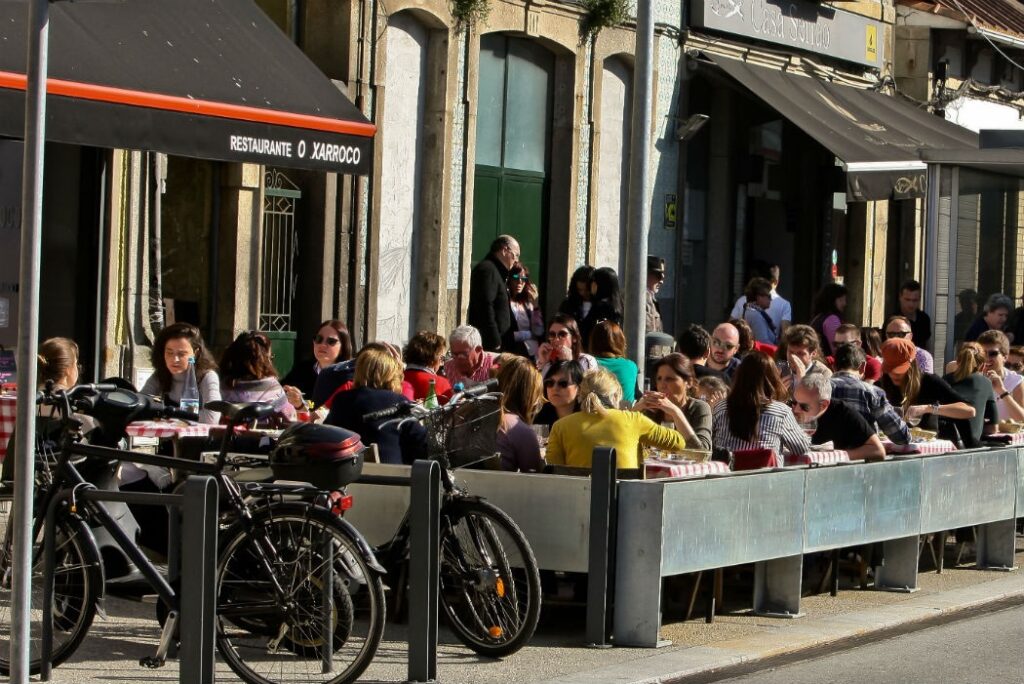
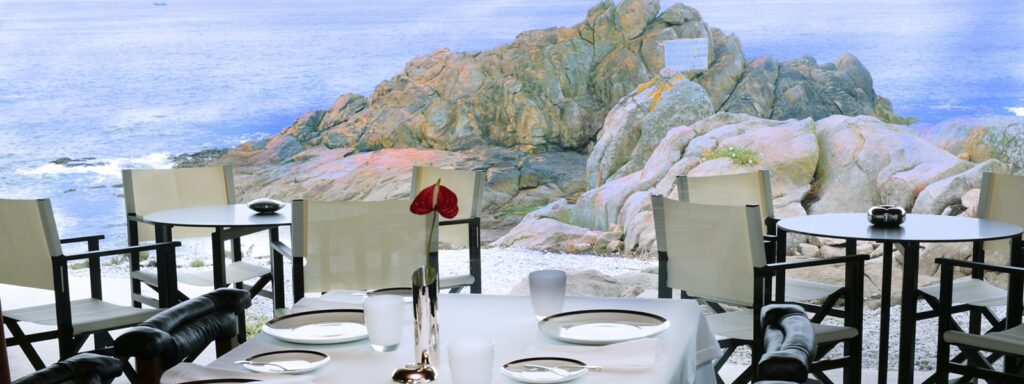
Matosinhos é muitas vezes considerado como o maior “cluster” europeu de restaurantes por metro quadrado, reunindo uma oferta ímpar. Ao todo, são cerca de 450 restaurantes, concentrados sobretudo nas partes mais antigas e tradicionais da cidade e junto à orla marítima. (© Câmara Municipal de Matosinhos).
Matosinhos is often considered the largest European cluster of restaurants per square meter, bringing together a unique offer. In total, there are about 450 restaurants, concentrated mainly in the oldest and most traditional parts of the city and along the seafront. (© Matosinhos City Hall).
A Câmara de Matosinhos assumiu a ambição de atingir a neutralidade carbónica até 2030. Tendo em conta a preponderância do setor dos transportes e logística para atingir esse fim, o que está previsto?
O Município de Matosinhos entende que o desafio das alterações climáticas representa uma crise existencial e urgente para a população no seu todo, com impacto na qualidade de vida e de saúde dos cidadãos, bem como com riscos imprevisíveis de catástrofes naturais. Por isso mesmo, queremos estar na linha da frente da ambição climática e antecipámos a meta estabelecida pelo Governo de Portugal para atingirmos a neutralidade carbónica. O país estabeleceu o ano de 2045 como referência, enquanto Matosinhos fixou já o ano de 2030. Por sua vez, o Porto de Leixões estabeleceu a meta de 2035.
Em 2020, a indústria representou 31% das emissões, seguida dos transportes com 25%. Por isso, é fundamental para a nossa cidade promover a mobilidade sustentável, a eficiência energética e a utilização de energias renováveis.
Já temos várias iniciativas em curso, como o Balcão Único de Aconselhamento Energético – Matosinhos Energy Hub, a reabilitação energética de conjuntos de habitação social, ou a produção descentralizada de energia em edifícios municipais ou habitação municipal.
Contudo, para atingirmos esta ambiciosa meta de neutralidade carbónica, iremos desenvolver mais ações nos próximos anos. Nos transportes, passa pelo reforço das redes de carregamento, da eletrificação de frota, bem como do incentivo à mobilidade suave e à utilização de transportes públicos. Nos processos industriais, queremos implementar processos de investigação e de inovação para a sustentabilidade, bem como a promoção de uma economia industrial hipocarbónica.
Para todos estes drivers de descarbonização, queremos contar sempre com o envolvimento e compromisso dos stakeholders locais, bem como da academia e dos centros de investigação.
The Matosinhos City Council has assumed the ambition of achieving carbon neutrality by 2030. Considering the preponderance of the transport and logistics sector to achieve this goal, what is planned?
The Municipality of Matosinhos understands that the challenge of climate change represents an existential and urgent crisis for the population as a whole, with an impact on the quality of life and health of citizens, as well as unpredictable risks of natural disasters. For this very reason, we want to be at the forefront of climate ambition and have anticipated the target set by the Government of Portugal to achieve carbon neutrality. The country has set 2045 as a reference year, while Matosinhos has already set 2030. In turn, the Port of Leixões has set a goal of 2035.
In 2020, industry represented 31% of emissions, followed by transport with 25%. It is therefore fundamental for our city to promote sustainable mobility, energy efficiency and the use of renewable energies.
We already have several initiatives underway, such as the One-Stop Shop for Energy Advice – Matosinhos Energy Hub, the energy rehabilitation of social housing blocks, or the decentralised production of energy in municipal buildings or municipal housing.
However, to achieve this ambitious goal of carbon neutrality, we will develop further actions in the coming years. In transport, it involves strengthening charging networks, fleet electrification, as well as encouraging soft mobility and the use of public transport. In industrial processes, we want to implement research and innovation processes for sustainability, as well as the promotion of a low-carbon industrial economy.
For all these decarbonisation drivers, we always want to count on the involvement and commitment of local stakeholders, as well as academia and research centres.
O Porto de Leixões é também um local de tráfego de cruzeiros. Em que medida a cidade procura conciliar o benefício económico que decorre desta movimentação com os impactos ambientais que lhe estão associados?
Sendo inegável a importância do Porto de Leixões para a economia local e regional, é igualmente incontestável que as atividades e fluxos que ocorrem na cidade, entre as quais o tráfego de cruzeiros, acarreta um conjunto de externalidades negativas e de impactos ambientais.
Estas consequências fazem sentir-se a vários níveis, com destaque para a poluição atmosférica e para a emissão de poluentes para a costa, com impactos na saúde humana e dos ecossistemas. O incremento da carga transacionada através do transporte marítimo, a par da maior importância das cadeias de logística, criam pressões adicionais.
The Port of Leixões is also a place of cruise ship traffic. To what extent does the city try to reconcile the economic benefit derived from this traffic with its associated environmental impacts?
Being undeniable the importance of the Port of Leixões for the local and regional economy, it is equally undeniable that the activities and flows that occur in the city, among which cruise traffic, entail a set of negative externalities and environmental impacts.
These consequences are felt at various levels, especially air pollution and the emission of pollutants to the coast, with impacts on human health and ecosystems. The increase in cargo transacted through maritime transport, together with the greater importance of logistics chains, create additional pressures.
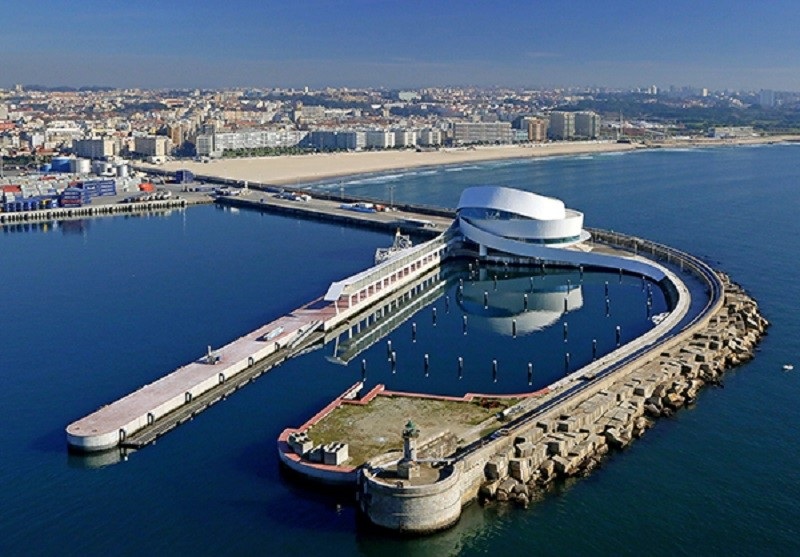
Atento ao impacto ambiental do crescimento do transporte marítmo o municipio de Matosinhos tem em curso um plano de reforço da capacidade da cidade em capturar carbono. (© Câmara Municipal de Matosinhos).
Aware of the environmental impact of the growth of maritime transport, the municipality of Matosinhos has an ongoing plan to strengthen the city’s capacity to capture carbon. (© Matosinhos City Hall).
Neste sentido, a Câmara Municipal está a apostar no reforço da capacidade da cidade em capturar carbono, por via do incremento da área arborizada, na oferta de mais zonas de parque, na promoção de mais área permeável no tecido urbano, entre outras medidas, que estão a ser desenvolvidas no quadro da Estrutura Verde Urbana, em elaboração.
No caso concreto do transporte marítimo, a legislação europeia também tem agido, nomeadamente com a imposição de limites máximos de emissões, com os navios mais recentes a reduzirem significativamente as emissões de óxido de enxofre, azoto, ou dióxido de carbono.
De uma forma geral, contamos que o próprio ramo de atividade económica evolua para soluções de operacionalização com menos impacto ambiental. Do nosso lado, temos igualmente procurado assumir uma posição de crescente proatividade na monitorização da qualidade do ar e da água.
In this sense, the City Council is investing in strengthening the city’s capacity to capture carbon, by increasing the wooded area, in offering more park areas, in promoting more permeable area in the urban fabric, among other measures, which are being developed in the framework of the Urban Green Structure, currently under preparation.
In the specific case of maritime transport, European legislation has also acted, namely by imposing maximum emission limits, with the newest ships significantly reducing emissions of sulphur oxide, nitrogen, or carbon dioxide.
In general, we expect the branch of economic activity itself to evolve towards operational solutions with less environmental impact. On our side, we have also been increasingly proactive in monitoring air and water quality.
A economia azul é um importante pilar da estratégia económica de Matosinhos. De que forma tem a Câmara de Matosinhos procurado ser um pivot de dinamização deste cluster?
A economia azul apresenta-se para Matosinhos como uma componente natural e fundamental da nossa estratégia de futuro. Em primeiro lugar, pela nossa tradição e forte ligação ao mar. Em segundo lugar, pela nossa ambição do ponto de vista da transição energética rumo a uma economia verde e sustentável. Em terceiro lugar, pela nossa vontade de gerar emprego altamente qualificado na economia local.
Este é um segmento muito importante para a nossa economia do ponto de vista da empregabilidade e reúne setores tão diversificados como os transportes marítimos, portos e logística; a pesca e indústria do pescado; a náutica de recreio e turismo náutico; a energia, minerais e bioteconologia; e ainda a investigação científica, desenvolvimento e inovação.
The blue economy is an important pillar of the economic strategy of Matosinhos. In what way has the Matosinhos City Hall sought to be a pivot to boost this cluster?
For Matosinhos, the blue economy is a natural and fundamental component of our strategy for the future. Firstly, due to our tradition and strong connection to the sea. Secondly, due to our ambition in terms of energy transition towards a green and sustainable economy. Thirdly, by our will to generate highly qualified employment in the local economy.
This is a very important segment for our economy in terms of employability and brings together sectors as diversified as maritime transport, ports and logistics; fishing and the fish industry; recreational boating and nautical tourism; energy, minerals and biotechnology; and also, scientific research, development and innovation.
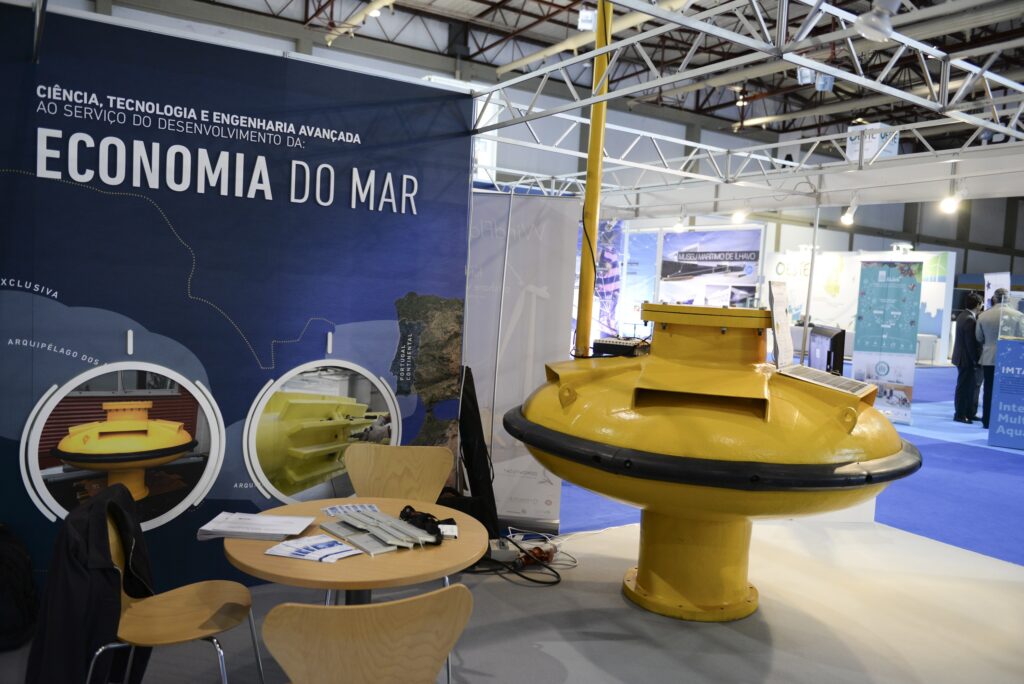
A economia azul é um segmento muito importante para a economia local, agregando setores diversificados: transportes marítimos, portos e logística; pesca e indústria do pescado náutica de recreio e turismo náutico; energia, minerais e bioteconologia; investigação científica, desenvolvimento e inovação. (© Câmara Municipal de Matosinhos).
The blue economy is a very important segment for the local economy, aggregating diversified sectors: maritime transport, ports, and logistics; fishing and fish industry; recreational boating and nautical tourism; energy, minerals, and biotechnology; scientific research, development, and innovation. (© Matosinhos City Hall).
A nossa visão para este sector tem sido pautada por esta dualidade de valorização da nossa tradição combinada com uma liderança nas transições digital e climática. Por outro lado, temos procurado assumir a posição de pivot de ligação entre empresas, associações e unidades de investigação, com vista a consolidar este setor.
Para o futuro, uma medida particularmente importante consiste na criação de um polo de desenvolvimento tecnológico cujos temas centrais são a energia e o mar. Denomina-se Centro Tecnológico da Energia e do Mar e congrega um conjunto diversificado de entidades como universidades, laboratórios de investigação, associações empresariais e empresas relevantes nestas áreas.
Este polo visa estabelecer na cidade uma dinâmica de atratividade e de instalação de inovação assente em empresas industriais, de serviços, espaços de pesquisa de ponta, unidades piloto industriais, que operem articuladamente, numa lógica de cluster, no aprofundamento do conhecimento e no incremento económico nestes domínios.
Our vision for this sector has been guided by this duality of valuing our tradition combined with a leadership in the digital and climate transitions. On the other hand, we have sought to assume the position of a pivotal link between companies, associations, and research units, with a view to consolidating this sector.
For the future, a particularly important measure is the creation of a technology development pole whose central themes are energy and the sea. It is called the Energy and Sea Technology Centre and brings together a diverse set of entities such as universities, research laboratories, business associations and relevant companies in these areas.
This pole aims to establish in the city a dynamic of attraction and installation of innovation based on industrial companies, services, cutting-edge research spaces, industrial pilot units, which operate in articulation, in a cluster logic, in the deepening of knowledge and economic growth in these areas.
A inovação nas cidades, numa lógica de smart cities, é apontada como uma forma de adaptar os territórios de forma a melhor servirem as suas comunidades. Que medidas têm sido implementadas pelo Município de Matosinhos neste domínio?
A nossa filosofia tem sido de abertura à experimentação e à inovação como veículos para melhorar a qualidade de vida dos matosinhenses.
Fomos a primeira cidade de Portugal a implementar uma Zona Livre Tecnológica, que correspondeu à definição de uma zona de Matosinhos na qual fosse possível testar tecnologias, produtos, ou serviços baseados em tecnologias inovadoras. Fomos também a primeira cidade a ter cobertura completa da rede de 5G.
De igual forma, temos o Living Lab Matosinhos, com um foco na transição energética e digital, que possibilita a testagem, experimentação e demonstração tecnológica de soluções de mobilidade, energia, ambiente e edifícios, numa lógica de “bairros inteligentes”.
Além disso, temos procurado participar em projetos que promovam o bem-estar da nossa população. É exemplo disso o ATELIER, um projeto europeu que pretende interligar a noção de cidade inteligente com as ambições de eficiência energética, de integração de energias renováveis, ou de promoção de formas sustentáveis de mobilidade.
Innovation in cities, in a smart city’s logic, is pointed out to adapt the territories to better serve their communities. What measures have been implemented by the Municipality of Matosinhos in this domain?
Our philosophy has been to be open to experimentation and innovation as vehicles to improve the quality of life of the people of Matosinhos.
We were the first city in Portugal to implement a Technological Free Zone, which corresponded to the definition of an area of Matosinhos in which it was possible to test technologies, products, or services based on innovative technologies. We were also the first city to have full 5G network coverage.
Likewise, we have the Living Lab Matosinhos, with a focus on energy and digital transition, which enables testing, experimentation and technological demonstration of mobility, energy, environment and building solutions, in a logic of “intelligent neighbourhoods”.
In addition, we have sought to participate in projects that promote the well-being of our population. An example of this is ATELIER, a European project that intends to interconnect the notion of smart city with the ambitions of energy efficiency, integration of renewable energies or promotion of sustainable forms of mobility.
A cidade de Matosinhos tem também várias dimensões de atração turística, sendo disso exemplos a gastronomia, ou a arquitetura. De que forma é feita a triangulação entre o Município de Matosinhos, o Porto de Leixões e o tecido empresarial para capitalizar esse potencial?
Posso afirmar com confiança que, hoje, Matosinhos beneficia de uma oferta ampla e diversificada de fatores de interesse turístico. Compete à Câmara Municipal, desde logo, apoiar o desenvolvimento e a promoção destas atividades, no que se inclui a sua divulgação e o desenvolvimento do turismo a elas associado.
The city of Matosinhos also has several tourist attraction dimensions, examples of which are gastronomy and architecture. How is the triangulation between the Municipality of Matosinhos, the Port of Leixões and the business community done to capitalise on this potential?
I can confidently state that, today, Matosinhos benefits from a wide and diversified offer of factors of touristic interest. It is up to the City Hall to support the development and promotion of these activities, including their dissemination and the development of tourism associated with them.
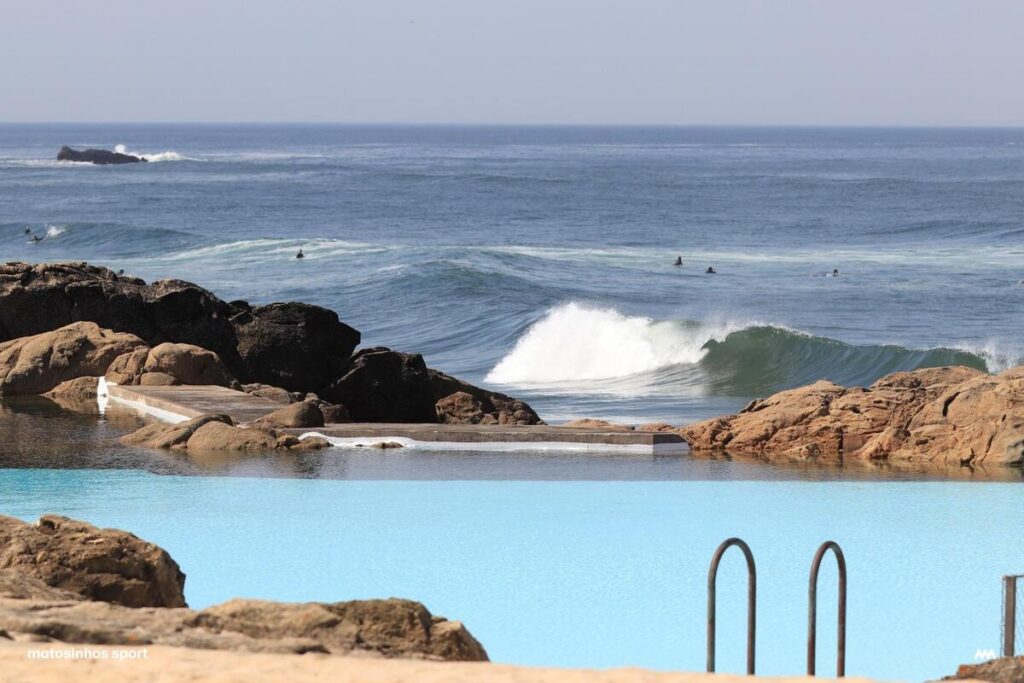
“Piscina das Marés” designed by architect Álvaro Siza Vieira. (© Matosinhos Sport / Câmara Municipal de Matosinhos).
“Piscina das Marés” designed by architect Álvaro Siza Vieira. (© Matosinhos Sport / Matosinhos City Hall).
Com o turismo gastronómico, o nosso trabalho está patente no esforço de adaptação do espaço público aos restaurantes do bairro gastronómico de Matosinhos, mediante a criação de espaços de esplanada, de condições técnicas e de infraestruturas e da oferta de áreas de estacionamento.
No campo da arquitetura, é feito um significativo investimento na atividade da Casa da Arquitetura, quer ao nível da sua programação, quer do trabalho de arquivo, como forma de afirmação institucional e científica. A relevância da arquitetura na cidade tem tradução na integração dos edifícios contemporâneos no trabalho que se tem desenvolvido de inventariação e classificação do património arquitetónico e arqueológico.
Mas envolvemos também o nosso tecido empresarial, ao prestar apoio e cooperação constante a uma linha de turismo de eventos e cooperativo, dos quais o QSP Summit é um bom exemplo, que se revestem como oportunidades de crescimento para as empresas matosinhenses.
A este respeito, importa ainda sublinhar que estamos a desenvolver um Observatório do Turismo em Matosinhos, que irá gerar conhecimento sobre quem nos visita, quais as suas motivações para nos visitar e quais as necessidades e expectativas dos agentes locais no momento atual.
With gastronomic tourism, our work is evident in the effort to adapt public space to the restaurants in Matosinhos’ gastronomic quarter, through the creation of terrace spaces, technical conditions and infrastructures and the offer of parking areas.
In the field of architecture, significant investment is made in the activity of the Casa da Arquitetura (House of Architecture), both in terms of its programming and archival work, as a form of institutional and scientific affirmation. The relevance of architecture in the city is reflected in the integration of contemporary buildings in the work of inventorying and classifying the architectural and archaeological heritage.
But we also involve our business fabric, by providing constant support and cooperation to a line of event and cooperative tourism, of which the QSP Summit is a good example, which are growth opportunities for Matosinhos companies.
In this regard, it is also important to underline that we are developing a Tourism Observatory in Matosinhos, which will generate knowledge about who visits us, what their motivations are for visiting us and what the needs and expectations of local agents are at the present time.
Matosinhos tem também na sua história setores tradicionais ligados à pesca ou à indústria conserveira. Como tem sido a integração destas áreas numa realidade económica mais competitiva, procurando garantir em simultâneo a sua proteção enquanto património histórico da cidade?
Estas são áreas “vivas”, onde os valores patrimoniais são assegurados pela vitalidade da atividade económica em si, exercida em espaços preservados e onde as práticas tradicionais e consolidadas se integrem nas novas tecnologias e contribuem para a qualidade dos produtos.
Na cidade, continuam a localizar-se grande parte das fábricas e unidades de congelação do peixe, sendo os edifícios reabilitados dentro das condições de enquadramento e da valorização do meio urbano que podem exercer.
Matosinhos also has in its history traditional sectors linked to fishing or canning. How has the integration of these areas into a more competitive economic reality been, trying to guarantee simultaneously their protection as historical heritage of the city?
These are “living” areas, where heritage values are ensured by the vitality of the economic activity itself, carried out in preserved spaces and where traditional and consolidated practices are integrated with new technologies and contribute to the quality of the products.
Most of the factories and fish freezing units are still located in the city, and the buildings have been rehabilitated in accordance with the framework conditions and the value they can add to the urban environment.
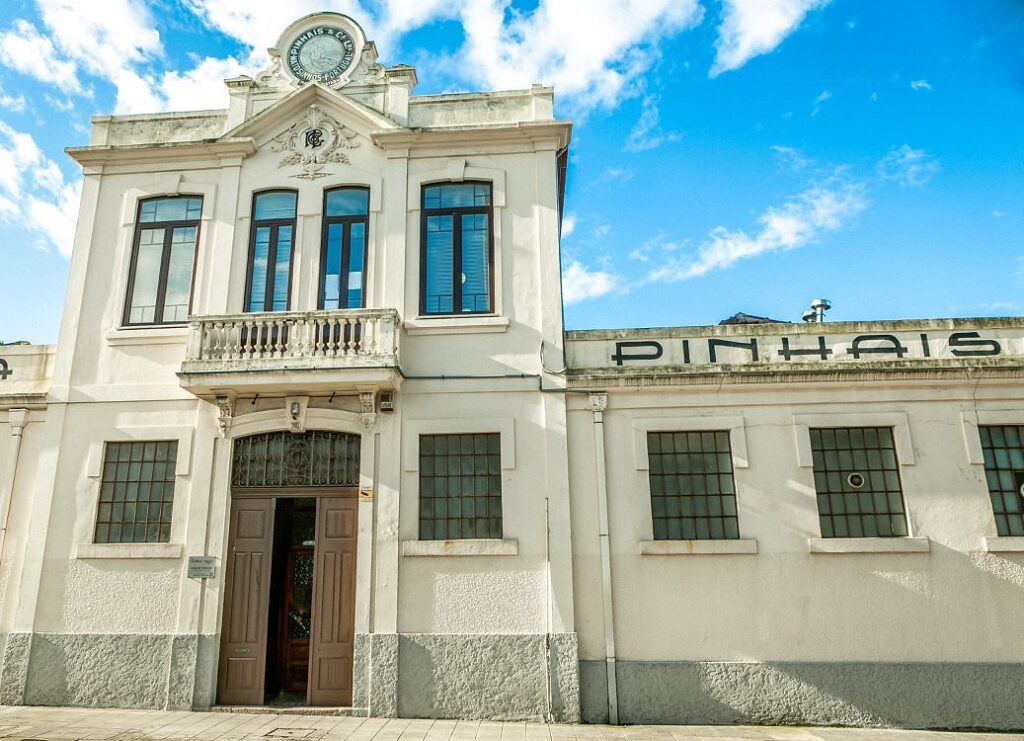
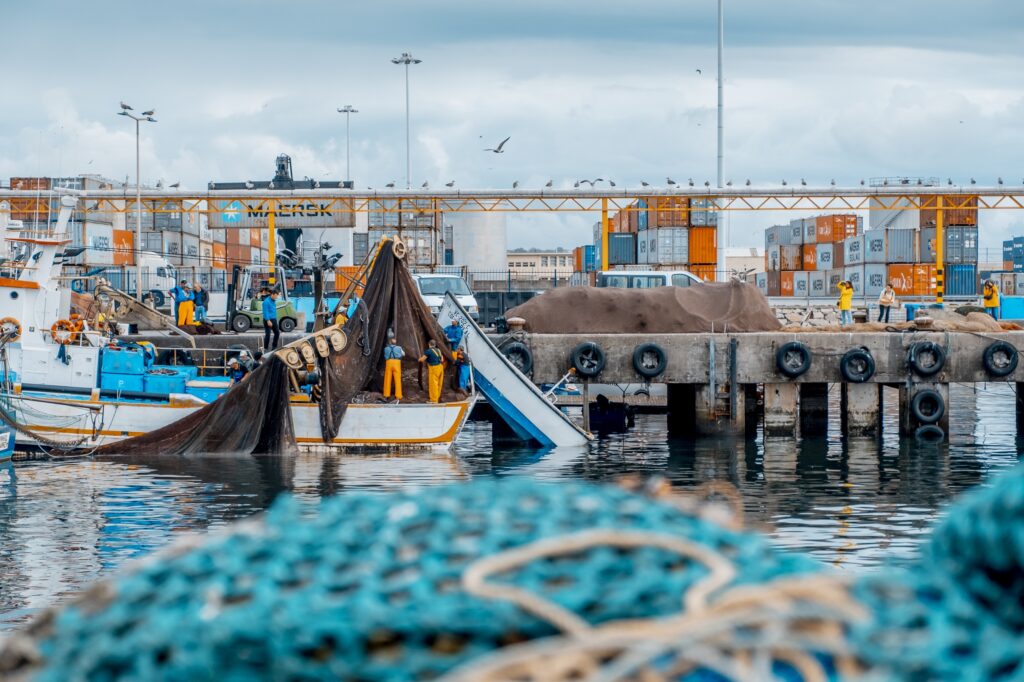
Os setores tradicionais de Matosinhos ligados à pesca e à indústria conserveira continuam hoje a afirmar-se como áreas “vivas” da cidade, quer ao nível económico, quer ao nível cultural e turístico. (© Câmara Municipal de Matosinhos e © msubirats, 2020).
The traditional sectors of Matosinhos linked to fishing and canning industry continue to assert themselves today as “living” areas of the city, both economically and culturally and in terms of tourism. (© Matosinhos City Hall and © msubirats, 2020).
Têm sido associados espaços de comercialização direta das conservas e foi também criada uma vertente museológica na Fábrica Pinhais, onde é possível conhecer as instalações e a própria atividade.
A Câmara Municipal está também a trabalhar com o Porto de Pesca no sentido de aumentar o contacto da cidade e da população com a atividade desenvolvida, criando pontos de acesso e de visita, a comercialização direta dos produtos do mar e a abertura dos espaços em eventos ao longo do ano.
There have been spaces for the direct commercialisation of the canned products and a museum has also been created in the Pinhais Factory, where it is possible to get to know the facilities and the activity itself.
The City Council is also working with the Fishing Port to increase the contact of the city and the population with the activity developed, creating access and visit points, the direct commercialisation of sea products and the opening of the spaces in events throughout the year.
Qual tem sido a abordagem de Matosinhos no planeamento da cidade, nomeadamente tendo em conta as pressões e desafios no domínio da logística?
A perspetiva do Município de Matosinhos tem-se centrado na necessidade de controlar os impactes da logística, dado tratar-se de uma atividade que consome grandes áreas do território e gera significativos volumes de tráfego.
Matosinhos encontra-se num nó dos diversos modos de transporte e tem, como tal, uma grande procura pelas empresas e um papel central neste sistema, que se procura desenvolver preservando a qualidade urbana do concelho.
A logística tem sido condicionada em termos dos locais onde pode ocorrer, em que condições, com que acessibilidades e cumprindo exigências que a Câmara Municipal tem feito ao nível do seu mais adequado enquadramento face ao que está previsto no Plano Diretor Municipal para o efeito.
What has been Matosinhos’ approach to city planning, namely considering the pressures and challenges in the field of logistics?
Matosinhos Municipality’s perspective has focused on the need to control the impacts of logistics, since it is an activity that consumes large areas of the territory and generates significant volumes of traffic.
Matosinhos is located at a node of the various modes of transport and, as such, is in great demand by companies and has a central role in this system, which we seek to develop while preserving the urban quality of the municipality. Logistics have been conditioned in terms of the places where they can take place, under what conditions, with what accessibility and complying with demands that the Town Hall has made in terms of its most appropriate environment in relation to what is foreseen in the Municipal Master Plan for this purpose.
Tendo em conta a relevância de Matosinhos em termos económicos, como se consolida essa posição num mundo global e competitivo?
Estando simultaneamente numa confluência de infraestruturas e junto ao mar, Matosinhos tem uma procura e um crescimento superiores à média nacional como local para a instalação de serviços, de atividades comerciais e para residência, sendo que estas vertentes se desenvolvem atualmente em conjunto.
Nesta perspetiva, a preocupação é a de absorver esta dinâmica de crescimento, acompanhando e melhorando a oferta que temos em termos de qualidade das infraestruturas, da qualidade do espaço urbano e das atividades e vivência da cidade.
Considering the relevance of Matosinhos in economic terms, how does it consolidate that position in a global and competitive world?
Being simultaneously in a confluence of infrastructures and next to the sea, Matosinhos has a demand and a growth higher than the national average as a place for the installation of services, commercial activities and residence, and these aspects are currently developing together.
From this perspective, the concern is to absorb this growth dynamic, accompanying and improving the offer we have in terms of the quality of infrastructures, the quality of urban space and the activities and experience of the city.
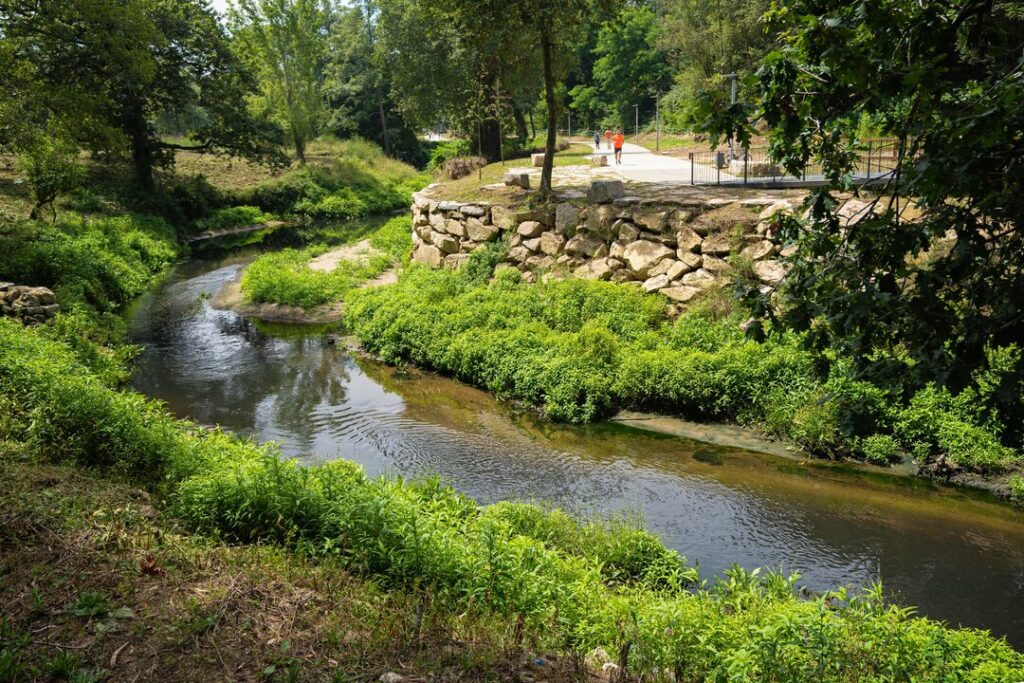
Ampliar a oferta dos espaços verdes é um dos caminhos preconizados pelo município para mitigar impactos ambientais. Exemplo desta estratégia é o “Corredor Verde do Leça”, um projeto ambiental e de mobilidade, com um forte cariz cultural, económico, turístico e social, de valorização paisagística e ambiental do rio Leça e das suas margens. (© Câmara Municipal de Matosinhos).
Expanding the offer of green spaces is one of the ways recommended by the municipality to mitigate environmental impacts. An example of this strategy is the “Leça’s Green Corridor”, an environmental and mobility project, with a strong cultural, economic, touristic and social character, of landscape and environmental valorization of Leça´s river and its margins. (© Matosinhos City Hall).
O Município de Matosinhos está, assim, focado em promover uma qualidade de vida transversal e multidimensional, que garanta à população uma oferta estruturada e continuada em áreas como a educação, o desporto, ou a cultura.
Por outro lado, é imprescindível para esta cidade ampliar significativamente a oferta de espaços verdes. Temos o fantástico exemplo do trabalho que está a ser desenvolvido no Corredor Verde do Leça, que representa um gigante esforço intermunicipal de requalificação e despoluição do Rio Leça, que está a devolver à comunidade as margens do rio para atividades de lazer ou desporto ao ar livre.
Em síntese, o caráter diferenciador de Matosinhos é, cada vez mais, a sua capacidade e a sua ambição de combinar um território que é muito dinâmico e inovador do ponto de vista económico, com uma oferta de equipamentos, serviços e espaços que permitam aos matosinhenses usufruirem de uma vida feliz e saudável.
The Municipality of Matosinhos is thus focused on promoting a transversal and multidimensional quality of life, which guarantees the population a structured and continuous offer in areas such as education, sport, and culture.
On the other hand, it is essential for this city to significantly expand the supply of green spaces. We have the fantastic example of the work being done in the Leça Green Corridor, which represents a giant inter-municipal effort to requalify and de-pollute the Leça River, which is returning the riverbanks to the community for leisure activities or outdoor sports.
In summary, the differentiating character of Matosinhos is, more and more, its capacity and ambition to combine a territory that is very dynamic and innovative from an economic point of view, with an offer of equipment, services and spaces that allow the inhabitants of Matosinhos to enjoy a happy and healthy life.
IMAGEM INICIAL | She Changes, localmente conhecida como a “A Anémona”, é uma escultura pública internacionalmente premiada de autoria da famosa artista americana Janet Echelman que presta homenagem à comunidade piscatória local. O seu estado de permanente mudança simboliza também a capacidade de adaptação e mudança que fazem parte do ADN de Matosinhos. (© Câmara Municipal de Matosinhos).
HEAD IMAGE | She Changes, locally known as “A Anémona”, is an internationally awarded public sculpture by the famous American artist Janet Echelman that pays tribute to the local fishing community. Its state of permanent change also symbolizes the capacity for adaptation and change that is part of Matosinhos’ DNA. (© Matosinhos City Hall).